Financial Management: Concepts, Statements, and Performance Analysis
VerifiedAdded on 2023/06/08
|14
|2910
|271
Report
AI Summary
This report delves into the core concepts of financial management, emphasizing the importance of funds management for business operations and growth. It defines financial management as the planning, financing, and management of assets to maximize business value, highlighting the significance of positive cash flow. The report explores the procurement and utilization of funds, discussing sources like debentures, venture capital, and commercial loans, as well as the role of a funds manager in ensuring optimal financial borrowings. It then moves on to describe the main financial statements, including the balance sheet, profit and loss account, and cash flow statement, detailing their components and purposes. The report further explains financial ratios, categorizing them into liquidity, efficiency, and profitability ratios, and demonstrating their use in assessing a company's performance, strength, and potential risks. Using a provided case study, the report analyzes the company's profitability, liquidity, and efficiency based on ratio analysis and includes the creation of an income statement and balance sheet using Excel. Finally, it discusses processes the business could use to improve its financial performance based on the case study's findings.
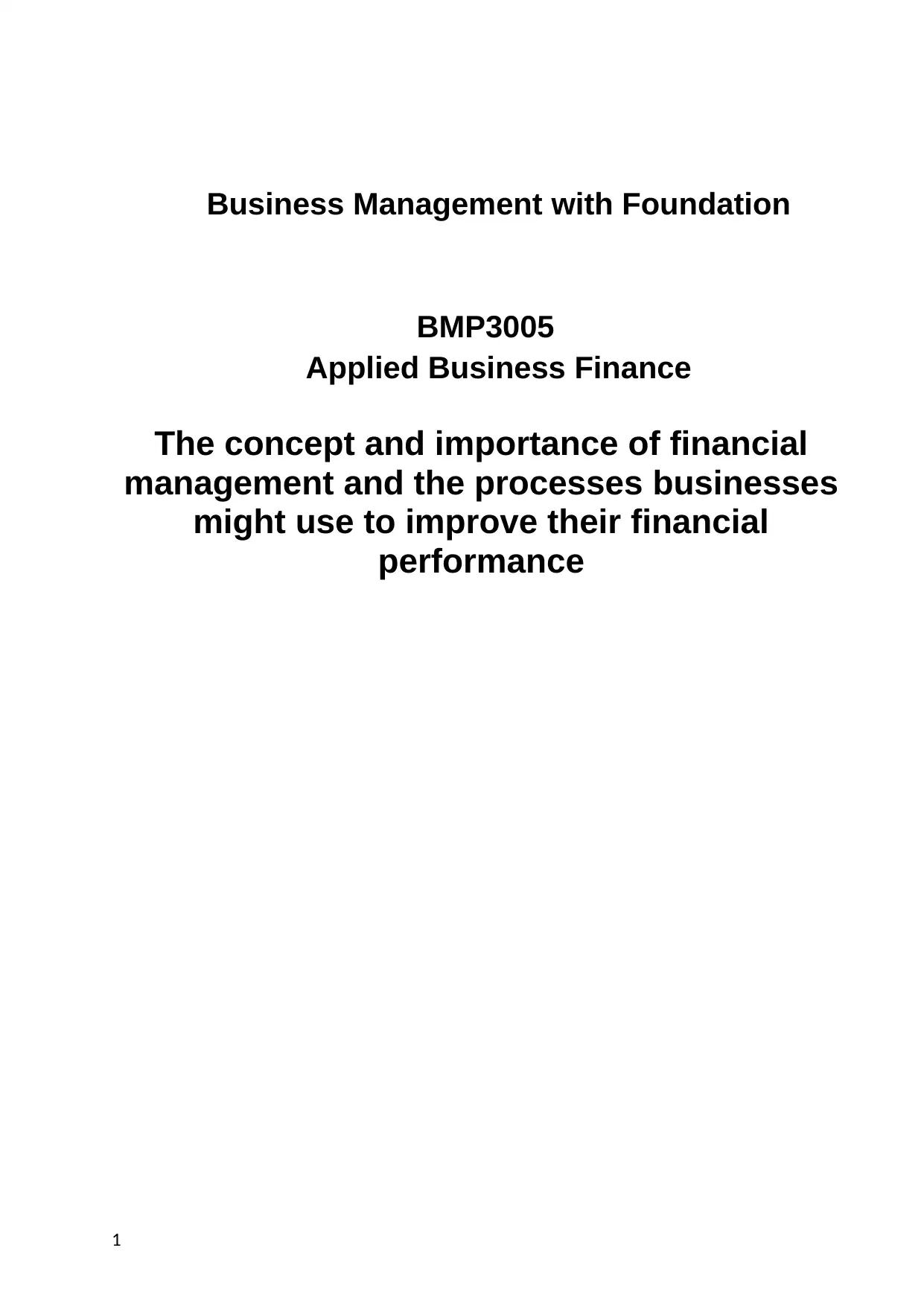
Business Management with Foundation
BMP3005
Applied Business Finance
The concept and importance of financial
management and the processes businesses
might use to improve their financial
performance
1
BMP3005
Applied Business Finance
The concept and importance of financial
management and the processes businesses
might use to improve their financial
performance
1
Paraphrase This Document
Need a fresh take? Get an instant paraphrase of this document with our AI Paraphraser
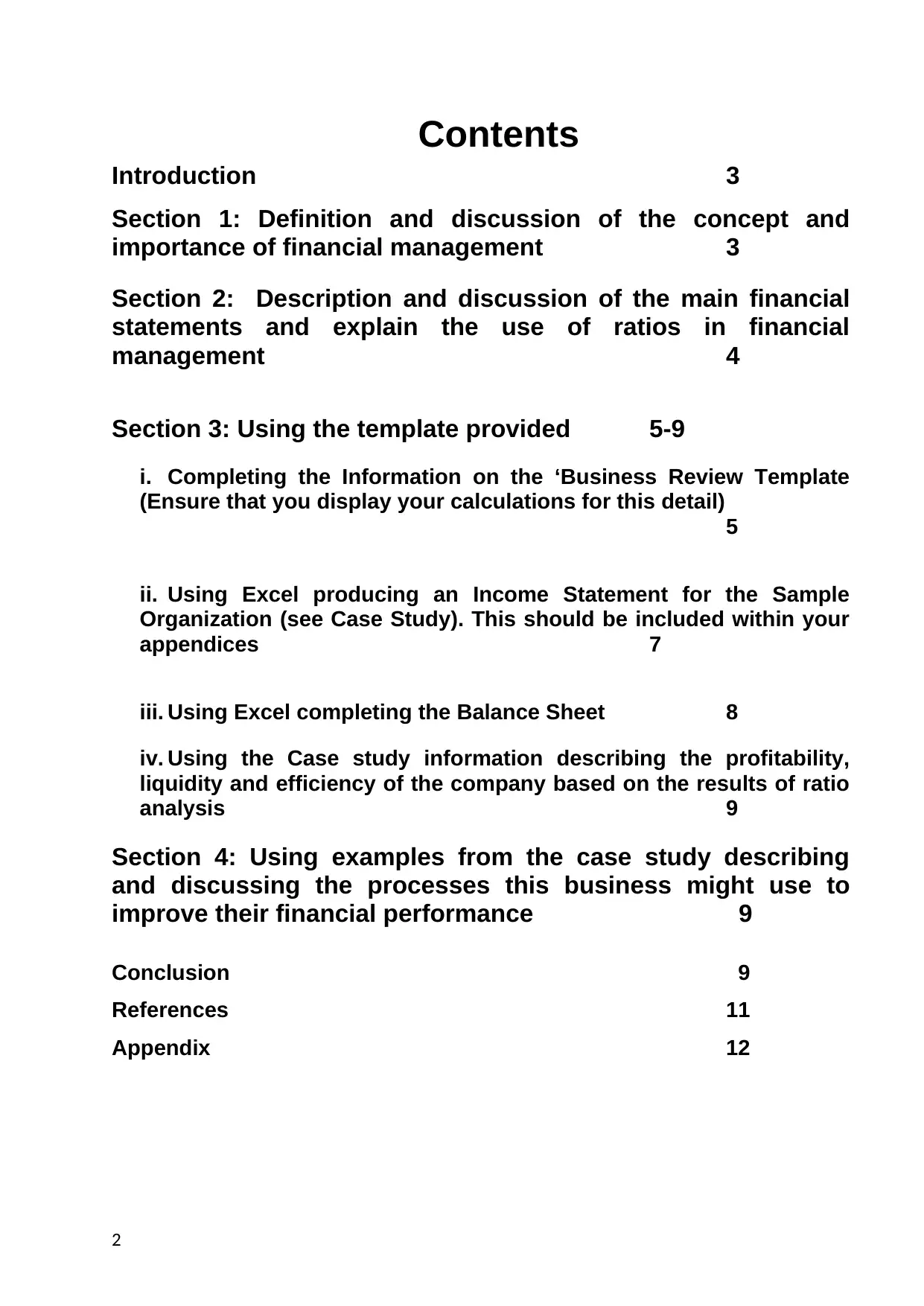
Contents
Introduction 3
Section 1: Definition and discussion of the concept and
importance of financial management 3
Section 2: Description and discussion of the main financial
statements and explain the use of ratios in financial
management 4
Section 3: Using the template provided 5-9
i. Completing the Information on the ‘Business Review Template
(Ensure that you display your calculations for this detail)
5
ii. Using Excel producing an Income Statement for the Sample
Organization (see Case Study). This should be included within your
appendices 7
iii. Using Excel completing the Balance Sheet 8
iv. Using the Case study information describing the profitability,
liquidity and efficiency of the company based on the results of ratio
analysis 9
Section 4: Using examples from the case study describing
and discussing the processes this business might use to
improve their financial performance 9
Conclusion 9
References 11
Appendix 12
2
Introduction 3
Section 1: Definition and discussion of the concept and
importance of financial management 3
Section 2: Description and discussion of the main financial
statements and explain the use of ratios in financial
management 4
Section 3: Using the template provided 5-9
i. Completing the Information on the ‘Business Review Template
(Ensure that you display your calculations for this detail)
5
ii. Using Excel producing an Income Statement for the Sample
Organization (see Case Study). This should be included within your
appendices 7
iii. Using Excel completing the Balance Sheet 8
iv. Using the Case study information describing the profitability,
liquidity and efficiency of the company based on the results of ratio
analysis 9
Section 4: Using examples from the case study describing
and discussing the processes this business might use to
improve their financial performance 9
Conclusion 9
References 11
Appendix 12
2
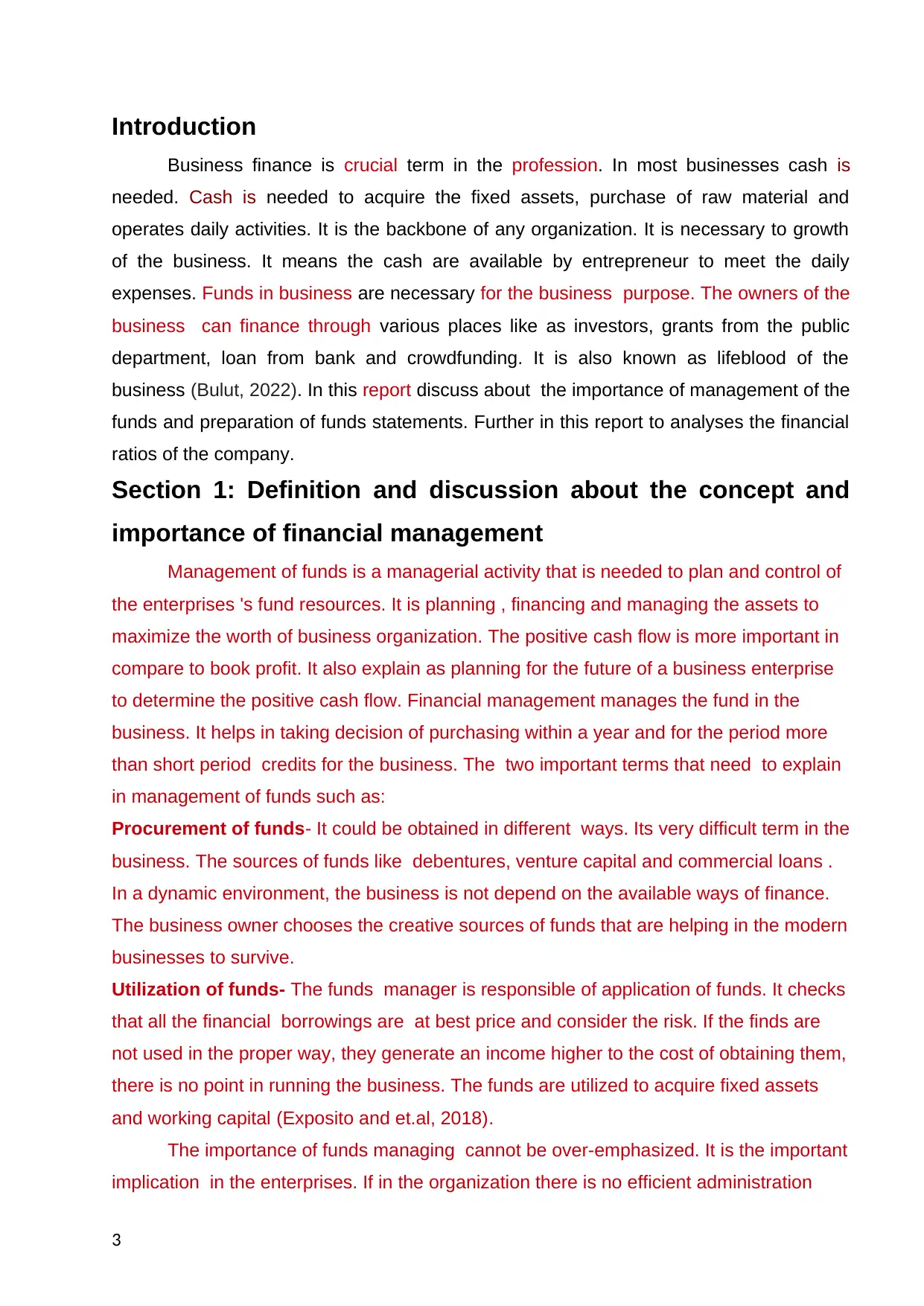
Introduction
Business finance is crucial term in the profession. In most businesses cash is
needed. Cash is needed to acquire the fixed assets, purchase of raw material and
operates daily activities. It is the backbone of any organization. It is necessary to growth
of the business. It means the cash are available by entrepreneur to meet the daily
expenses. Funds in business are necessary for the business purpose. The owners of the
business can finance through various places like as investors, grants from the public
department, loan from bank and crowdfunding. It is also known as lifeblood of the
business (Bulut, 2022). In this report discuss about the importance of management of the
funds and preparation of funds statements. Further in this report to analyses the financial
ratios of the company.
Section 1: Definition and discussion about the concept and
importance of financial management
Management of funds is a managerial activity that is needed to plan and control of
the enterprises 's fund resources. It is planning , financing and managing the assets to
maximize the worth of business organization. The positive cash flow is more important in
compare to book profit. It also explain as planning for the future of a business enterprise
to determine the positive cash flow. Financial management manages the fund in the
business. It helps in taking decision of purchasing within a year and for the period more
than short period credits for the business. The two important terms that need to explain
in management of funds such as:
Procurement of funds- It could be obtained in different ways. Its very difficult term in the
business. The sources of funds like debentures, venture capital and commercial loans .
In a dynamic environment, the business is not depend on the available ways of finance.
The business owner chooses the creative sources of funds that are helping in the modern
businesses to survive.
Utilization of funds- The funds manager is responsible of application of funds. It checks
that all the financial borrowings are at best price and consider the risk. If the finds are
not used in the proper way, they generate an income higher to the cost of obtaining them,
there is no point in running the business. The funds are utilized to acquire fixed assets
and working capital (Exposito and et.al, 2018).
The importance of funds managing cannot be over-emphasized. It is the important
implication in the enterprises. If in the organization there is no efficient administration
3
Business finance is crucial term in the profession. In most businesses cash is
needed. Cash is needed to acquire the fixed assets, purchase of raw material and
operates daily activities. It is the backbone of any organization. It is necessary to growth
of the business. It means the cash are available by entrepreneur to meet the daily
expenses. Funds in business are necessary for the business purpose. The owners of the
business can finance through various places like as investors, grants from the public
department, loan from bank and crowdfunding. It is also known as lifeblood of the
business (Bulut, 2022). In this report discuss about the importance of management of the
funds and preparation of funds statements. Further in this report to analyses the financial
ratios of the company.
Section 1: Definition and discussion about the concept and
importance of financial management
Management of funds is a managerial activity that is needed to plan and control of
the enterprises 's fund resources. It is planning , financing and managing the assets to
maximize the worth of business organization. The positive cash flow is more important in
compare to book profit. It also explain as planning for the future of a business enterprise
to determine the positive cash flow. Financial management manages the fund in the
business. It helps in taking decision of purchasing within a year and for the period more
than short period credits for the business. The two important terms that need to explain
in management of funds such as:
Procurement of funds- It could be obtained in different ways. Its very difficult term in the
business. The sources of funds like debentures, venture capital and commercial loans .
In a dynamic environment, the business is not depend on the available ways of finance.
The business owner chooses the creative sources of funds that are helping in the modern
businesses to survive.
Utilization of funds- The funds manager is responsible of application of funds. It checks
that all the financial borrowings are at best price and consider the risk. If the finds are
not used in the proper way, they generate an income higher to the cost of obtaining them,
there is no point in running the business. The funds are utilized to acquire fixed assets
and working capital (Exposito and et.al, 2018).
The importance of funds managing cannot be over-emphasized. It is the important
implication in the enterprises. If in the organization there is no efficient administration
3
⊘ This is a preview!⊘
Do you want full access?
Subscribe today to unlock all pages.

Trusted by 1+ million students worldwide
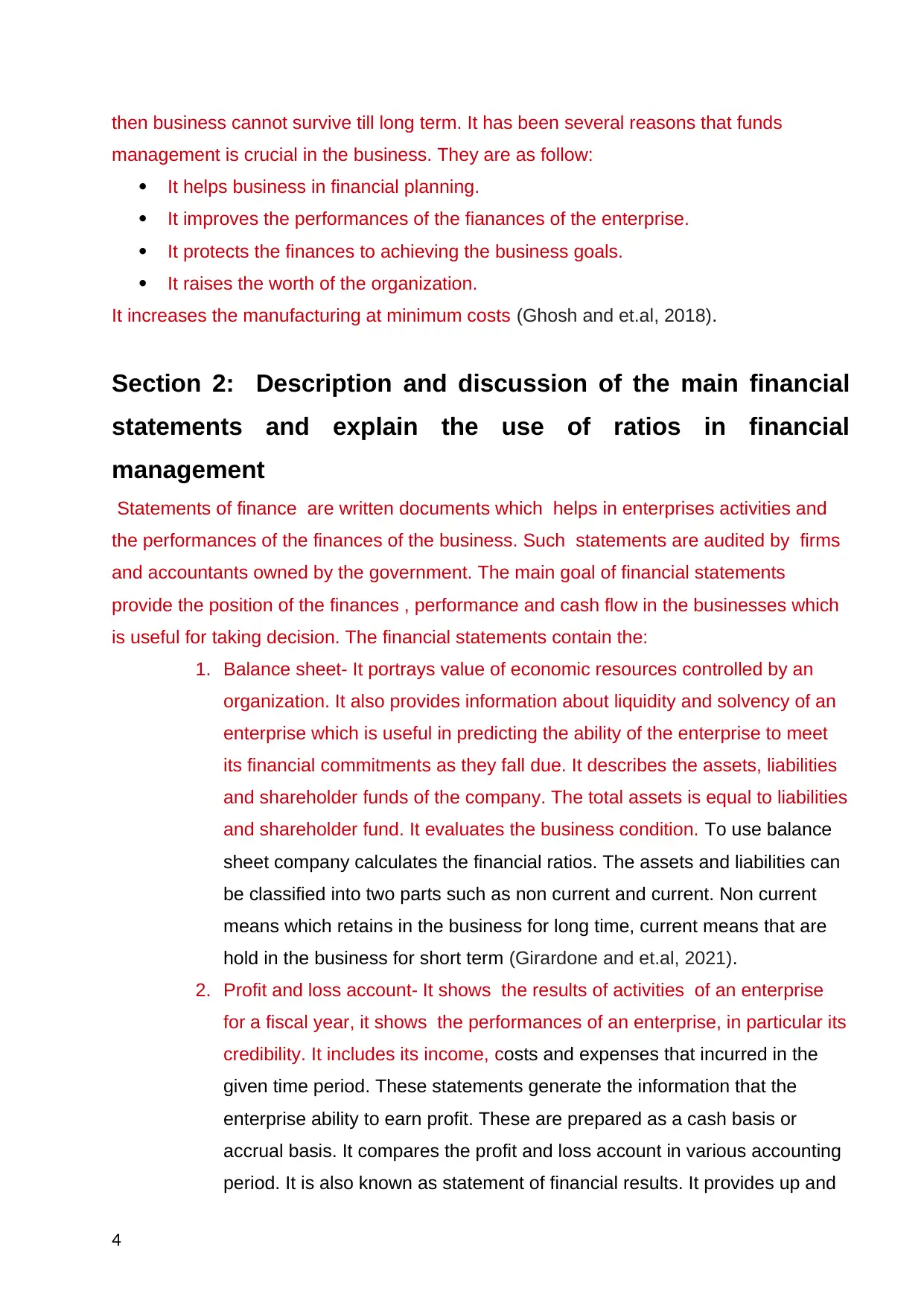
then business cannot survive till long term. It has been several reasons that funds
management is crucial in the business. They are as follow:
It helps business in financial planning.
It improves the performances of the fianances of the enterprise.
It protects the finances to achieving the business goals.
It raises the worth of the organization.
It increases the manufacturing at minimum costs (Ghosh and et.al, 2018).
Section 2: Description and discussion of the main financial
statements and explain the use of ratios in financial
management
Statements of finance are written documents which helps in enterprises activities and
the performances of the finances of the business. Such statements are audited by firms
and accountants owned by the government. The main goal of financial statements
provide the position of the finances , performance and cash flow in the businesses which
is useful for taking decision. The financial statements contain the:
1. Balance sheet- It portrays value of economic resources controlled by an
organization. It also provides information about liquidity and solvency of an
enterprise which is useful in predicting the ability of the enterprise to meet
its financial commitments as they fall due. It describes the assets, liabilities
and shareholder funds of the company. The total assets is equal to liabilities
and shareholder fund. It evaluates the business condition. To use balance
sheet company calculates the financial ratios. The assets and liabilities can
be classified into two parts such as non current and current. Non current
means which retains in the business for long time, current means that are
hold in the business for short term (Girardone and et.al, 2021).
2. Profit and loss account- It shows the results of activities of an enterprise
for a fiscal year, it shows the performances of an enterprise, in particular its
credibility. It includes its income, costs and expenses that incurred in the
given time period. These statements generate the information that the
enterprise ability to earn profit. These are prepared as a cash basis or
accrual basis. It compares the profit and loss account in various accounting
period. It is also known as statement of financial results. It provides up and
4
management is crucial in the business. They are as follow:
It helps business in financial planning.
It improves the performances of the fianances of the enterprise.
It protects the finances to achieving the business goals.
It raises the worth of the organization.
It increases the manufacturing at minimum costs (Ghosh and et.al, 2018).
Section 2: Description and discussion of the main financial
statements and explain the use of ratios in financial
management
Statements of finance are written documents which helps in enterprises activities and
the performances of the finances of the business. Such statements are audited by firms
and accountants owned by the government. The main goal of financial statements
provide the position of the finances , performance and cash flow in the businesses which
is useful for taking decision. The financial statements contain the:
1. Balance sheet- It portrays value of economic resources controlled by an
organization. It also provides information about liquidity and solvency of an
enterprise which is useful in predicting the ability of the enterprise to meet
its financial commitments as they fall due. It describes the assets, liabilities
and shareholder funds of the company. The total assets is equal to liabilities
and shareholder fund. It evaluates the business condition. To use balance
sheet company calculates the financial ratios. The assets and liabilities can
be classified into two parts such as non current and current. Non current
means which retains in the business for long time, current means that are
hold in the business for short term (Girardone and et.al, 2021).
2. Profit and loss account- It shows the results of activities of an enterprise
for a fiscal year, it shows the performances of an enterprise, in particular its
credibility. It includes its income, costs and expenses that incurred in the
given time period. These statements generate the information that the
enterprise ability to earn profit. These are prepared as a cash basis or
accrual basis. It compares the profit and loss account in various accounting
period. It is also known as statement of financial results. It provides up and
4
Paraphrase This Document
Need a fresh take? Get an instant paraphrase of this document with our AI Paraphraser
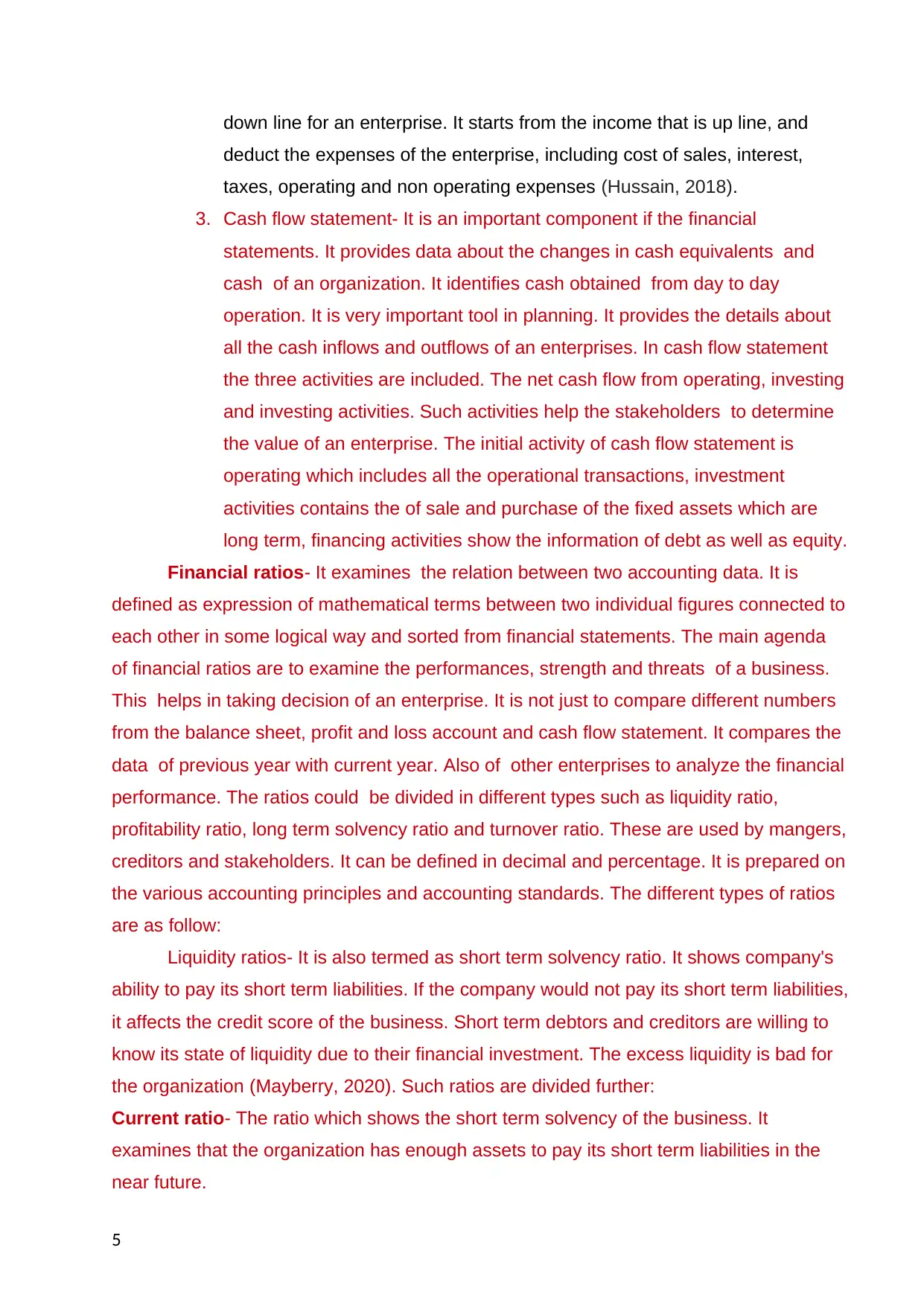
down line for an enterprise. It starts from the income that is up line, and
deduct the expenses of the enterprise, including cost of sales, interest,
taxes, operating and non operating expenses (Hussain, 2018).
3. Cash flow statement- It is an important component if the financial
statements. It provides data about the changes in cash equivalents and
cash of an organization. It identifies cash obtained from day to day
operation. It is very important tool in planning. It provides the details about
all the cash inflows and outflows of an enterprises. In cash flow statement
the three activities are included. The net cash flow from operating, investing
and investing activities. Such activities help the stakeholders to determine
the value of an enterprise. The initial activity of cash flow statement is
operating which includes all the operational transactions, investment
activities contains the of sale and purchase of the fixed assets which are
long term, financing activities show the information of debt as well as equity.
Financial ratios- It examines the relation between two accounting data. It is
defined as expression of mathematical terms between two individual figures connected to
each other in some logical way and sorted from financial statements. The main agenda
of financial ratios are to examine the performances, strength and threats of a business.
This helps in taking decision of an enterprise. It is not just to compare different numbers
from the balance sheet, profit and loss account and cash flow statement. It compares the
data of previous year with current year. Also of other enterprises to analyze the financial
performance. The ratios could be divided in different types such as liquidity ratio,
profitability ratio, long term solvency ratio and turnover ratio. These are used by mangers,
creditors and stakeholders. It can be defined in decimal and percentage. It is prepared on
the various accounting principles and accounting standards. The different types of ratios
are as follow:
Liquidity ratios- It is also termed as short term solvency ratio. It shows company's
ability to pay its short term liabilities. If the company would not pay its short term liabilities,
it affects the credit score of the business. Short term debtors and creditors are willing to
know its state of liquidity due to their financial investment. The excess liquidity is bad for
the organization (Mayberry, 2020). Such ratios are divided further:
Current ratio- The ratio which shows the short term solvency of the business. It
examines that the organization has enough assets to pay its short term liabilities in the
near future.
5
deduct the expenses of the enterprise, including cost of sales, interest,
taxes, operating and non operating expenses (Hussain, 2018).
3. Cash flow statement- It is an important component if the financial
statements. It provides data about the changes in cash equivalents and
cash of an organization. It identifies cash obtained from day to day
operation. It is very important tool in planning. It provides the details about
all the cash inflows and outflows of an enterprises. In cash flow statement
the three activities are included. The net cash flow from operating, investing
and investing activities. Such activities help the stakeholders to determine
the value of an enterprise. The initial activity of cash flow statement is
operating which includes all the operational transactions, investment
activities contains the of sale and purchase of the fixed assets which are
long term, financing activities show the information of debt as well as equity.
Financial ratios- It examines the relation between two accounting data. It is
defined as expression of mathematical terms between two individual figures connected to
each other in some logical way and sorted from financial statements. The main agenda
of financial ratios are to examine the performances, strength and threats of a business.
This helps in taking decision of an enterprise. It is not just to compare different numbers
from the balance sheet, profit and loss account and cash flow statement. It compares the
data of previous year with current year. Also of other enterprises to analyze the financial
performance. The ratios could be divided in different types such as liquidity ratio,
profitability ratio, long term solvency ratio and turnover ratio. These are used by mangers,
creditors and stakeholders. It can be defined in decimal and percentage. It is prepared on
the various accounting principles and accounting standards. The different types of ratios
are as follow:
Liquidity ratios- It is also termed as short term solvency ratio. It shows company's
ability to pay its short term liabilities. If the company would not pay its short term liabilities,
it affects the credit score of the business. Short term debtors and creditors are willing to
know its state of liquidity due to their financial investment. The excess liquidity is bad for
the organization (Mayberry, 2020). Such ratios are divided further:
Current ratio- The ratio which shows the short term solvency of the business. It
examines that the organization has enough assets to pay its short term liabilities in the
near future.
5
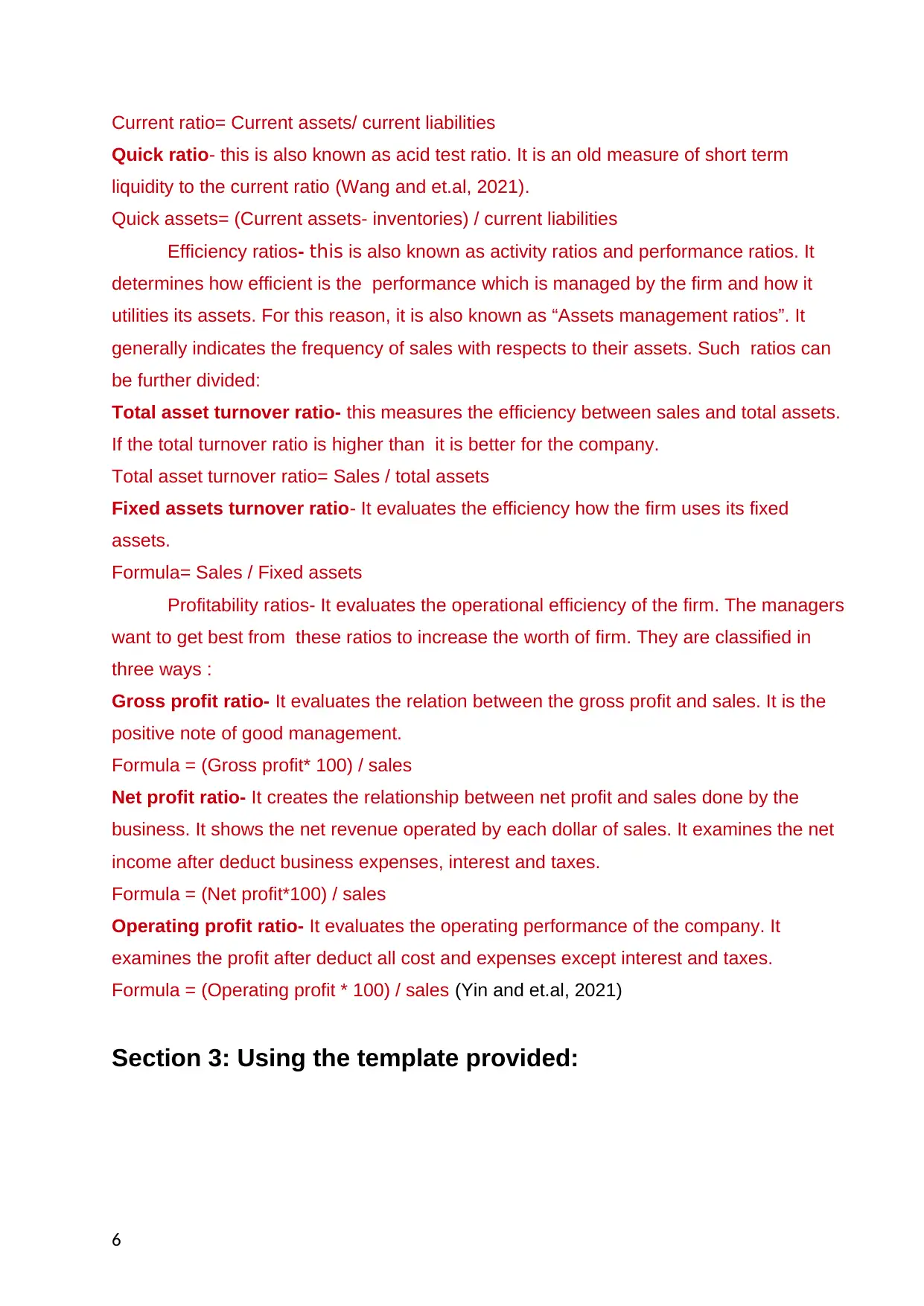
Current ratio= Current assets/ current liabilities
Quick ratio- this is also known as acid test ratio. It is an old measure of short term
liquidity to the current ratio (Wang and et.al, 2021).
Quick assets= (Current assets- inventories) / current liabilities
Efficiency ratios- this is also known as activity ratios and performance ratios. It
determines how efficient is the performance which is managed by the firm and how it
utilities its assets. For this reason, it is also known as “Assets management ratios”. It
generally indicates the frequency of sales with respects to their assets. Such ratios can
be further divided:
Total asset turnover ratio- this measures the efficiency between sales and total assets.
If the total turnover ratio is higher than it is better for the company.
Total asset turnover ratio= Sales / total assets
Fixed assets turnover ratio- It evaluates the efficiency how the firm uses its fixed
assets.
Formula= Sales / Fixed assets
Profitability ratios- It evaluates the operational efficiency of the firm. The managers
want to get best from these ratios to increase the worth of firm. They are classified in
three ways :
Gross profit ratio- It evaluates the relation between the gross profit and sales. It is the
positive note of good management.
Formula = (Gross profit* 100) / sales
Net profit ratio- It creates the relationship between net profit and sales done by the
business. It shows the net revenue operated by each dollar of sales. It examines the net
income after deduct business expenses, interest and taxes.
Formula = (Net profit*100) / sales
Operating profit ratio- It evaluates the operating performance of the company. It
examines the profit after deduct all cost and expenses except interest and taxes.
Formula = (Operating profit * 100) / sales (Yin and et.al, 2021)
Section 3: Using the template provided:
6
Quick ratio- this is also known as acid test ratio. It is an old measure of short term
liquidity to the current ratio (Wang and et.al, 2021).
Quick assets= (Current assets- inventories) / current liabilities
Efficiency ratios- this is also known as activity ratios and performance ratios. It
determines how efficient is the performance which is managed by the firm and how it
utilities its assets. For this reason, it is also known as “Assets management ratios”. It
generally indicates the frequency of sales with respects to their assets. Such ratios can
be further divided:
Total asset turnover ratio- this measures the efficiency between sales and total assets.
If the total turnover ratio is higher than it is better for the company.
Total asset turnover ratio= Sales / total assets
Fixed assets turnover ratio- It evaluates the efficiency how the firm uses its fixed
assets.
Formula= Sales / Fixed assets
Profitability ratios- It evaluates the operational efficiency of the firm. The managers
want to get best from these ratios to increase the worth of firm. They are classified in
three ways :
Gross profit ratio- It evaluates the relation between the gross profit and sales. It is the
positive note of good management.
Formula = (Gross profit* 100) / sales
Net profit ratio- It creates the relationship between net profit and sales done by the
business. It shows the net revenue operated by each dollar of sales. It examines the net
income after deduct business expenses, interest and taxes.
Formula = (Net profit*100) / sales
Operating profit ratio- It evaluates the operating performance of the company. It
examines the profit after deduct all cost and expenses except interest and taxes.
Formula = (Operating profit * 100) / sales (Yin and et.al, 2021)
Section 3: Using the template provided:
6
⊘ This is a preview!⊘
Do you want full access?
Subscribe today to unlock all pages.

Trusted by 1+ million students worldwide
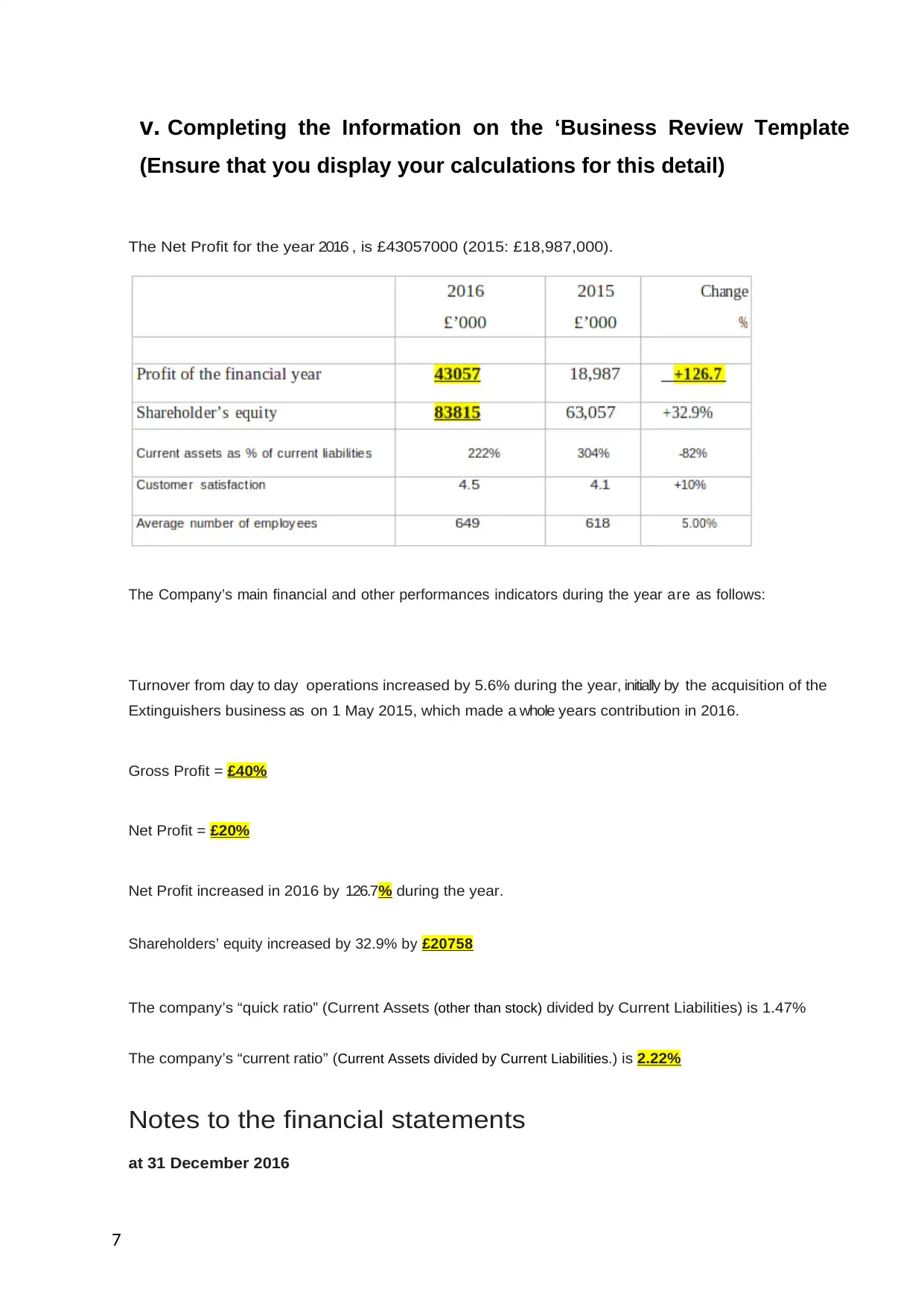
v. Completing the Information on the ‘Business Review Template
(Ensure that you display your calculations for this detail)
The Net Profit for the year 2016 , is £43057000 (2015: £18,987,000).
The Company’s main financial and other performances indicators during the year are as follows:
Turnover from day to day operations increased by 5.6% during the year, initially by the acquisition of the
Extinguishers business as on 1 May 2015, which made a whole years contribution in 2016.
Gross Profit = £40%
Net Profit = £20%
Net Profit increased in 2016 by 126.7% during the year.
Shareholders’ equity increased by 32.9% by £20758
The company’s “quick ratio” (Current Assets (other than stock) divided by Current Liabilities) is 1.47%
The company’s “current ratio” (Current Assets divided by Current Liabilities. ) is 2.22%
Notes to the financial statements
at 31 December 2016
7
(Ensure that you display your calculations for this detail)
The Net Profit for the year 2016 , is £43057000 (2015: £18,987,000).
The Company’s main financial and other performances indicators during the year are as follows:
Turnover from day to day operations increased by 5.6% during the year, initially by the acquisition of the
Extinguishers business as on 1 May 2015, which made a whole years contribution in 2016.
Gross Profit = £40%
Net Profit = £20%
Net Profit increased in 2016 by 126.7% during the year.
Shareholders’ equity increased by 32.9% by £20758
The company’s “quick ratio” (Current Assets (other than stock) divided by Current Liabilities) is 1.47%
The company’s “current ratio” (Current Assets divided by Current Liabilities. ) is 2.22%
Notes to the financial statements
at 31 December 2016
7
Paraphrase This Document
Need a fresh take? Get an instant paraphrase of this document with our AI Paraphraser
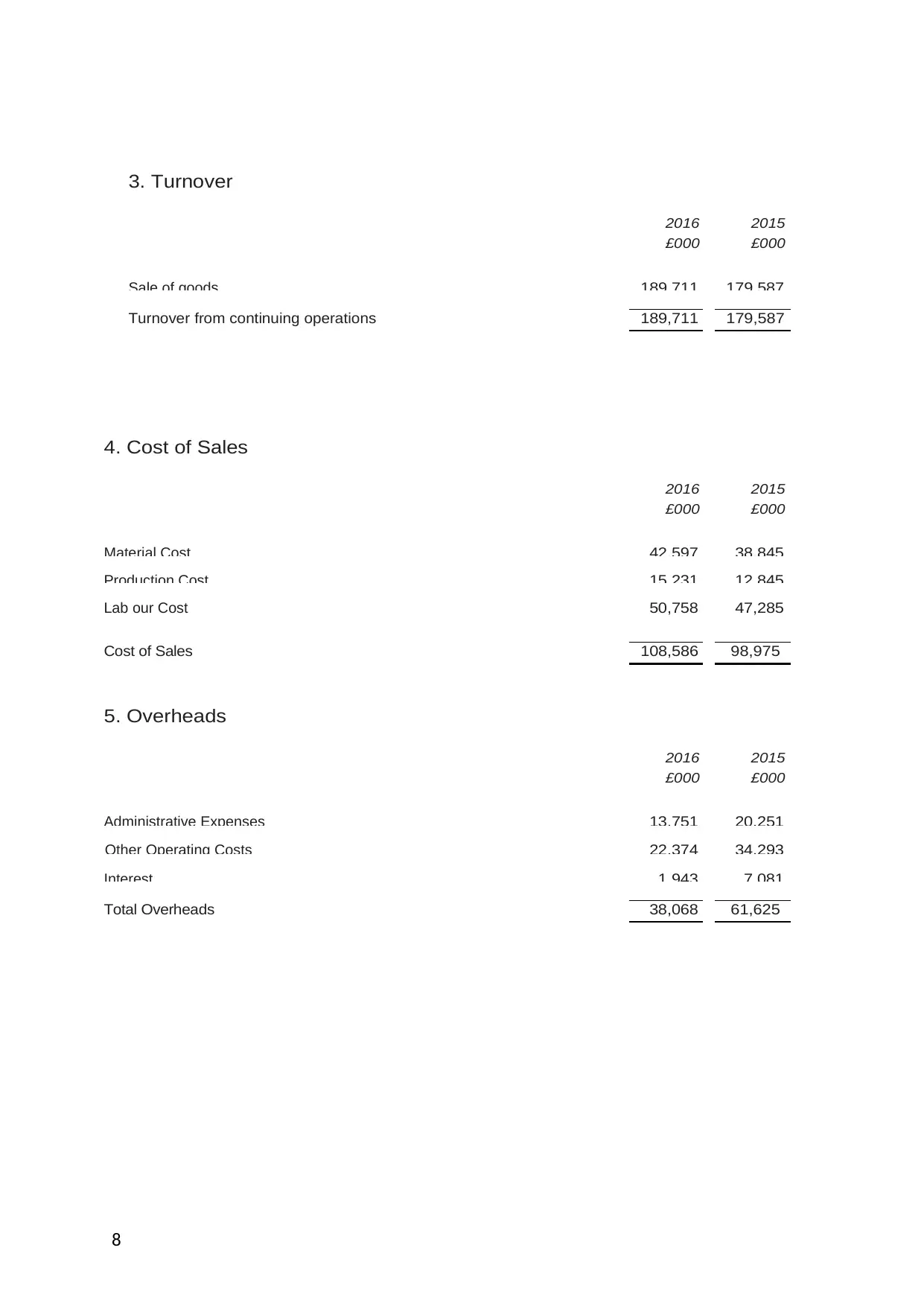
3. Turnover
2016 2015
£000 £000
Sale of goods 189,711 179,587
Turnover from continuing operations 189,711 179,587
4. Cost of Sales
2016 2015
£000 £000
Material Cost 42,597 38.845
Production Cost 15,231 12,845
Lab our Cost 50,758 47,285
Cost of Sales 108,586 98,975
5. Overheads
2016 2015
£000 £000
Administrative Expenses 13,751 20,251
Other Operating Costs 22,374 34,293
Interest 1,943 7,081
Total Overheads 38,068 61,625
8
2016 2015
£000 £000
Sale of goods 189,711 179,587
Turnover from continuing operations 189,711 179,587
4. Cost of Sales
2016 2015
£000 £000
Material Cost 42,597 38.845
Production Cost 15,231 12,845
Lab our Cost 50,758 47,285
Cost of Sales 108,586 98,975
5. Overheads
2016 2015
£000 £000
Administrative Expenses 13,751 20,251
Other Operating Costs 22,374 34,293
Interest 1,943 7,081
Total Overheads 38,068 61,625
8
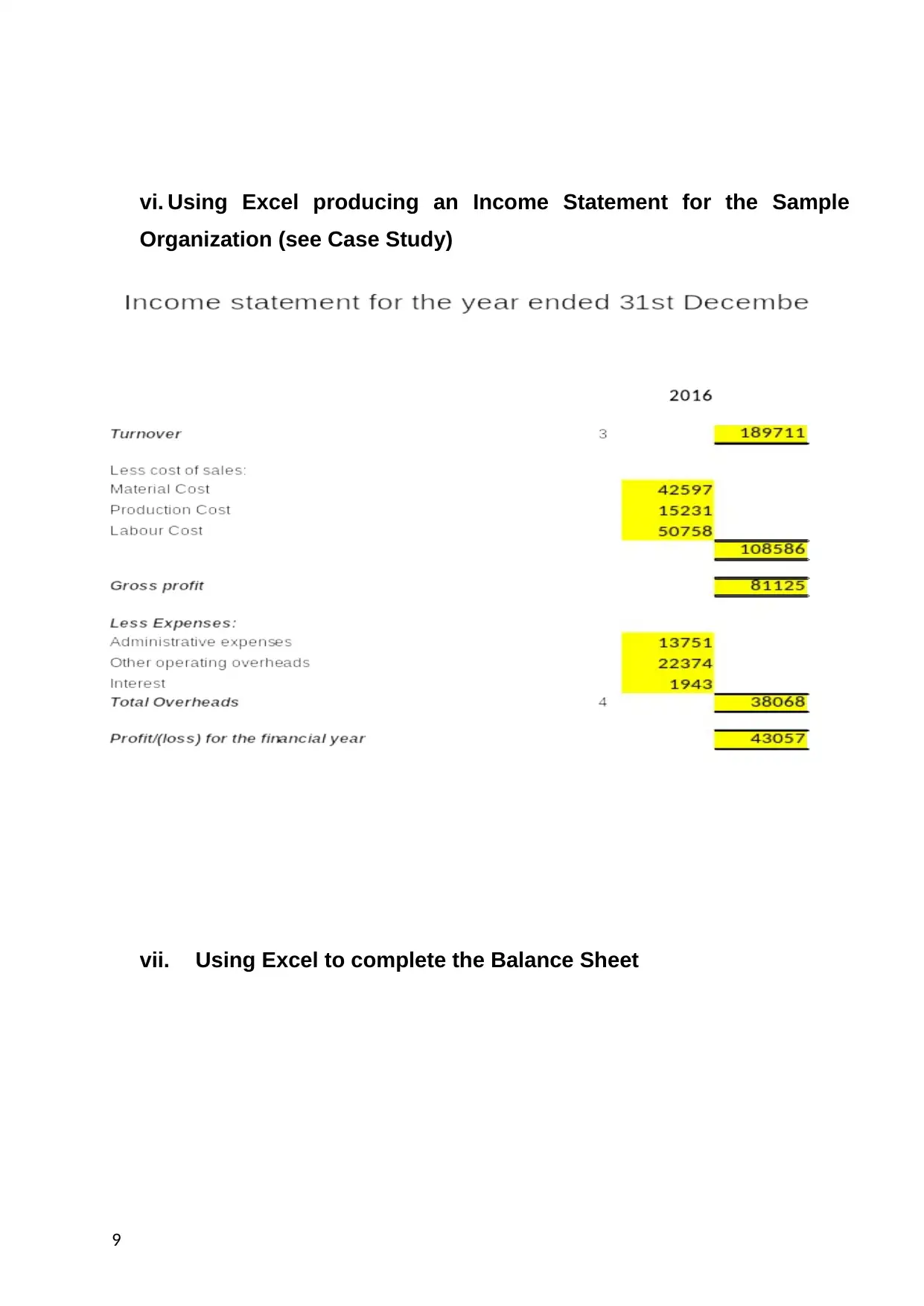
vi. Using Excel producing an Income Statement for the Sample
Organization (see Case Study)
vii. Using Excel to complete the Balance Sheet
9
Organization (see Case Study)
vii. Using Excel to complete the Balance Sheet
9
⊘ This is a preview!⊘
Do you want full access?
Subscribe today to unlock all pages.

Trusted by 1+ million students worldwide
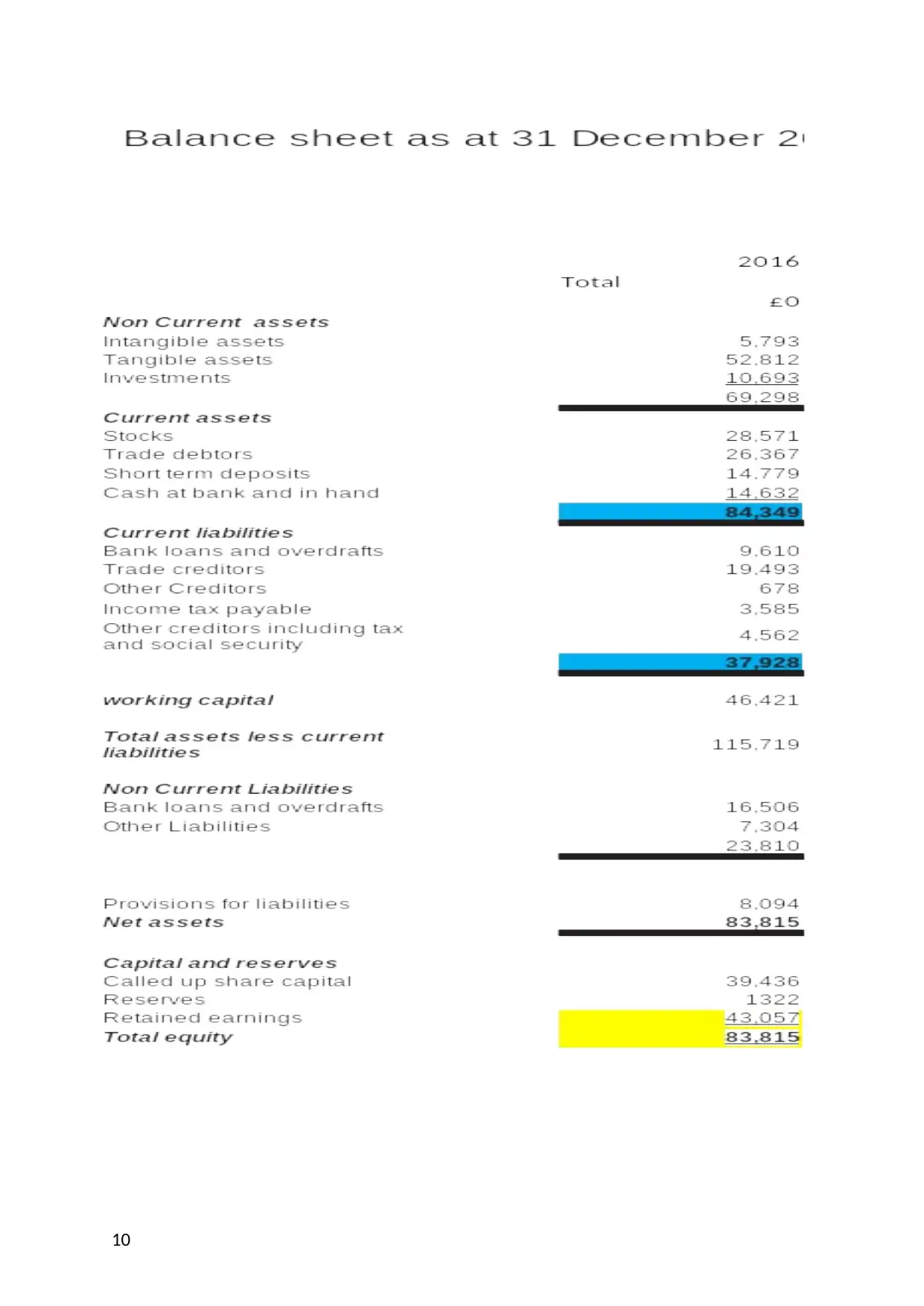
10
Paraphrase This Document
Need a fresh take? Get an instant paraphrase of this document with our AI Paraphraser
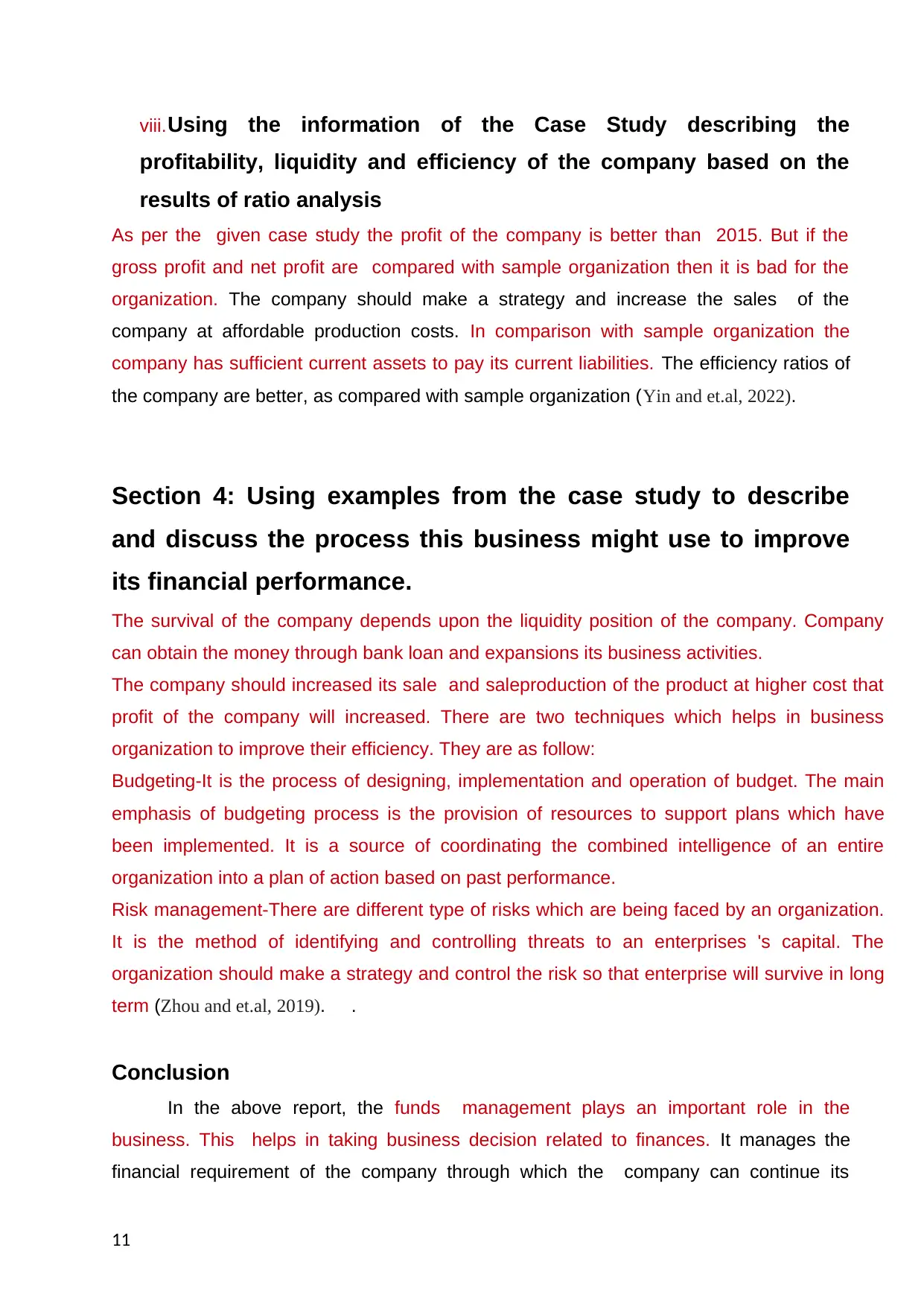
viii.Using the information of the Case Study describing the
profitability, liquidity and efficiency of the company based on the
results of ratio analysis
As per the given case study the profit of the company is better than 2015. But if the
gross profit and net profit are compared with sample organization then it is bad for the
organization. The company should make a strategy and increase the sales of the
company at affordable production costs. In comparison with sample organization the
company has sufficient current assets to pay its current liabilities. The efficiency ratios of
the company are better, as compared with sample organization (Yin and et.al, 2022).
Section 4: Using examples from the case study to describe
and discuss the process this business might use to improve
its financial performance.
The survival of the company depends upon the liquidity position of the company. Company
can obtain the money through bank loan and expansions its business activities.
The company should increased its sale and saleproduction of the product at higher cost that
profit of the company will increased. There are two techniques which helps in business
organization to improve their efficiency. They are as follow:
Budgeting-It is the process of designing, implementation and operation of budget. The main
emphasis of budgeting process is the provision of resources to support plans which have
been implemented. It is a source of coordinating the combined intelligence of an entire
organization into a plan of action based on past performance.
Risk management-There are different type of risks which are being faced by an organization.
It is the method of identifying and controlling threats to an enterprises 's capital. The
organization should make a strategy and control the risk so that enterprise will survive in long
term (Zhou and et.al, 2019). .
Conclusion
In the above report, the funds management plays an important role in the
business. This helps in taking business decision related to finances. It manages the
financial requirement of the company through which the company can continue its
11
profitability, liquidity and efficiency of the company based on the
results of ratio analysis
As per the given case study the profit of the company is better than 2015. But if the
gross profit and net profit are compared with sample organization then it is bad for the
organization. The company should make a strategy and increase the sales of the
company at affordable production costs. In comparison with sample organization the
company has sufficient current assets to pay its current liabilities. The efficiency ratios of
the company are better, as compared with sample organization (Yin and et.al, 2022).
Section 4: Using examples from the case study to describe
and discuss the process this business might use to improve
its financial performance.
The survival of the company depends upon the liquidity position of the company. Company
can obtain the money through bank loan and expansions its business activities.
The company should increased its sale and saleproduction of the product at higher cost that
profit of the company will increased. There are two techniques which helps in business
organization to improve their efficiency. They are as follow:
Budgeting-It is the process of designing, implementation and operation of budget. The main
emphasis of budgeting process is the provision of resources to support plans which have
been implemented. It is a source of coordinating the combined intelligence of an entire
organization into a plan of action based on past performance.
Risk management-There are different type of risks which are being faced by an organization.
It is the method of identifying and controlling threats to an enterprises 's capital. The
organization should make a strategy and control the risk so that enterprise will survive in long
term (Zhou and et.al, 2019). .
Conclusion
In the above report, the funds management plays an important role in the
business. This helps in taking business decision related to finances. It manages the
financial requirement of the company through which the company can continue its
11
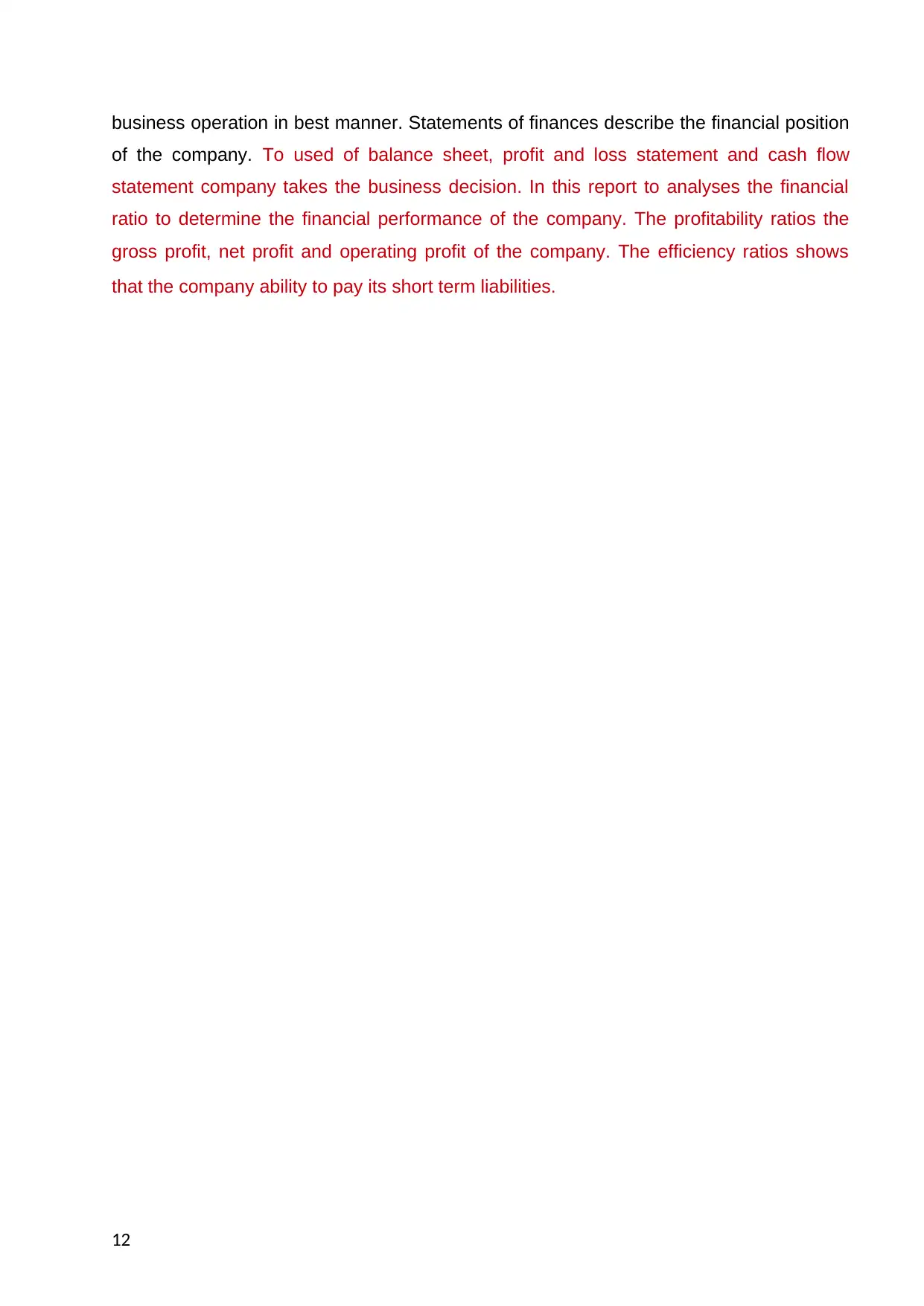
business operation in best manner. Statements of finances describe the financial position
of the company. To used of balance sheet, profit and loss statement and cash flow
statement company takes the business decision. In this report to analyses the financial
ratio to determine the financial performance of the company. The profitability ratios the
gross profit, net profit and operating profit of the company. The efficiency ratios shows
that the company ability to pay its short term liabilities.
12
of the company. To used of balance sheet, profit and loss statement and cash flow
statement company takes the business decision. In this report to analyses the financial
ratio to determine the financial performance of the company. The profitability ratios the
gross profit, net profit and operating profit of the company. The efficiency ratios shows
that the company ability to pay its short term liabilities.
12
⊘ This is a preview!⊘
Do you want full access?
Subscribe today to unlock all pages.

Trusted by 1+ million students worldwide
1 out of 14
Related Documents
Your All-in-One AI-Powered Toolkit for Academic Success.
+13062052269
info@desklib.com
Available 24*7 on WhatsApp / Email
![[object Object]](/_next/static/media/star-bottom.7253800d.svg)
Unlock your academic potential
Copyright © 2020–2025 A2Z Services. All Rights Reserved. Developed and managed by ZUCOL.

